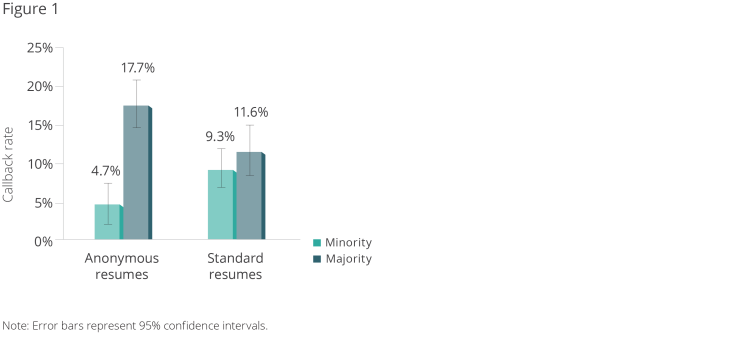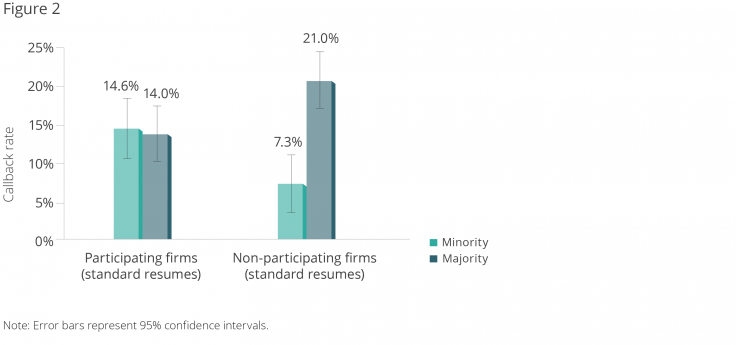Changing resumes to reduce hiring discrimination

Summary
There is strong evidence of discrimination against a large number of different minority1 and underrepresented groups in labor markets in many countries. One of many strategies being tested, removing some information from resumes could reduce discrimination in the first stage of the hiring process by limiting employers’ opportunities to screen out applicants based on name, photo, criminal background, or other identifying information.
This insight draws from 23 randomized correspondence studies2 that measure the extent of hiring discrimination in different markets and two evaluations that use randomization to identify the impact of removing identifying information from job applications. In these two evaluations, removing information increased discrimination, with researchers pointing to different mechanisms to explain why. In the first evaluation, the removal of this information made firms that otherwise already interviewed and hired more minority candidates less likely to do so. In the second, employers shifted discrimination to other characteristics. However, since it is well-documented from correspondence studies that the average firm in many contexts discriminates, mandatory anonymization and other strategies that change the way employers review applications should be tested further.
Supporting evidence
Rigorous research points to considerable discrimination in labor markets against a range of minority groups across many countries. Correspondence studies, which send fictitious resumes to job openings, have found strong evidence of widespread discrimination on the basis of race, ethnicity, immigration status, gender, religion, and sexual orientation. Randomized studies that took place in thirteen countries found discrimination in 27 out of 31 comparisons [1][2] [3][4] [5][6][7][8][9][10][11][12][13][14][15][16][17][18][19][20][21][22][23]. For example, a 2004 study in the United States found that applicants with white-sounding names were invited for job interviews 50 percent more often than equally qualified applicants with black-sounding names[7].3 One possible explanation for these results is that some employers may have stopped reading a resume whenever they saw a black-sounding name, never reaching that candidate’s qualifications.
The impact of anonymizing resumes seems to depend on the characteristics of the firms that received the anonymous resumes, namely whether they were discriminating against minority groups in the first place. An evaluation in France of anonymous resumes looked at the impact on firms that had volunteered to participate[26]. These firms were previously more likely to interview and hire minority candidates. Within this group, firms that received anonymous resumes interviewed and hired fewer minority candidates. In this case, removing information on minority status prevented the firms from favorably considering minority applicants. Since it is well-documented that the average firm in many contexts discriminates, mandatory anonymization might capture those firms who would not voluntarily anonymize their screening process and produce different results.
In France, participating firms were less likely to hire minority candidates with anonymous resumes (Figure 1), but firms participating in the study who were in the comparison group (received standard resumes) were more likely to hire minorities than non-participating firms (Figure 2).


Removing information on some characteristics might change the way firms review resumes and lead them to discriminate on other characteristics correlated with minority status. A study in the United States found more discrimination against black applicants after the implementation of a policy banning employers from asking about criminal histories on job applications [24]. Researchers suggest that when employers lacked individualized information about criminal history, they tended to generalize that black applicants were more likely than white applicants to have criminal records. Through similar channels, anonymization might have unintended effects on how employers review resumes in other contexts. For example, removing information could prevent firms from considering negative signals, like unemployment spells, in light of hardships that a minority candidate might have experienced [26].
Mandatory anonymization and other strategies that change the way that employers review applications should be tested. Given that in many contexts the average firm discriminates, mandatory anonymization might reduce discrimination by capturing firms who would not voluntarily anonymize their application review and may be more likely to discriminate. Since research suggests that some employers exercise “attention discrimination,” in which they pay less attention to applicants with minority-sounding names [25] mandatory anonymization and other solutions that counter this attention bias should be evaluated. Other potential solutions could include changing the order of information on a resume so that someone’s minority status is not revealed until the employer has read the candidate’s other information. More research is needed to understand how anonymization changes the way firms review resumes and how to reduce discrimination during subsequent stages of the application process. Future policies should also consider the net impact on discrimination against minorities by capturing both firms who were discriminating and those who were more likely to interview and hire minority applicants before the policy change.
Abdul Latif Jameel Poverty Action Lab (J-PAL). 2019. "Changing Resumes to Reduce Hiring Discrimination." J-PAL Policy Insights. Last modified February 2019. https://doi.org/10.31485/pi.2233.2019
For the purposes of this document, we define minority as any distinct group that is marginalized based on characteristics including, but not limited to, race, ethnicity, gender, sexual orientation, or religion.
A randomized correspondence study measures the prevalence of discrimination in hiring by sending fictitious resumes in response to job postings. Researchers develop a database of realistic and similar resumes and then randomly assign each resume to be from a minority or the majority group, signaled through an identifying characteristic on the resume.
To identify white-sounding names (like Emily Walsh) and black-sounding names (like Lakisha Washington), researchers calculated the frequency of names from the birth certificates of all babies born in the state of Massachusetts between 1974 and 1979.
Acquisti, Alessandro and Christina M. Fong. “An Experiment in Hiring Discrimination via Online Social Networks.” Working Paper, March 2016. Research Paper
Ahmed, Ali M., Lina Andersson, and Mats Hammarstedt. 2013. “Are Gay Men and Lesbians Discriminated against in the Hiring Process?” Southern Economic Journal 79 (3): 565–585. Research Paper
Baert, Stijn, Bart Cockx, Niels Gheyle, and Cora Vandamme. “Do Employers Discriminate Less If Vacancies Are Difficult to Fill? Evidence from a Field Experiment.” Institute for the Study of Labor (IZA) Discussion Paper #7145, January 2013. Research Paper
Bailey, John, Michael Wallace, and Bradley Wright. 2013. “Are Gay Men and Lesbians Discriminated Against When Applying for Jobs? A Four-City, Internet-Based Field Experiment.” Journal of Homosexuality 60 (6): 873–894. Research Paper
Banerjee, Abhijit, Marianne Bertrand, Saugato Datta, and Sendhil Mullainathan. 2009. “Labor Market Discrimination in Delhi: Evidence from a Field Experiment.”Journal of Comparative Economics 37 (1): 14 –27. Research Paper
Bartoš, Vojtěch, Michal Bauer, Julie Chytilová, and Filip Matějka. “Attention Discrimination: Theory and Field Experiments.” Center for Economic Research and Graduate Education (CERGE) Working Paper, December 2013. Research Paper
Bertrand, Marianne, and Sendhil Mullainathan. 2004. “Are Emily and Greg More Employable than Lakisha and Jamal? A Field Experiment on Labor Market Discrimination.” The American Economic Review 94 (4): 991–1013. Research Paper | J-PAL Evaluation Summary
Blommaert, Lieselotte, Marcel Coenders, and Frank van Tubergen. 2014. “Discrimination of Arabic-Named Applicants in the Netherlands: An Internet-Based Field Experiment Examining Different Phases in Online Recruitment Procedures.” Social Forces 92 (3): 957–982. Research Paper
Booth, Alison and Andrew Leigh. “Do Employers Discriminate by Gender? A Field Experiment in Female-Dominated Occupations.” Institute for the Study of Labor (IZA) Discussion Paper #4690, January 2010. Research Paper
Booth, Alison L., Andrew Leigh, and Elena Varganova. 2011. “Does Ethnic Discrimination Vary Across Minority Groups? Evidence from a Field Experiment.” Oxford Bulletin of Economics and Statistics 74 (4): 547–573. Research Paper
Bursell, Moa. “What’s in a Name? A Field Experiment Test for the Existence of Ethnic Discrimination in the Hiring Process. Working Paper, Stockholm, Sweden, November 2007. Research Paper
Carlsson, Magnus. 2011. “Does Hiring Discrimination Cause Gender Segregation in the Swedish Labor Market?” Feminist Economics17 (3): 71–102. Research Paper
Correll, Shelley J., Stephen Bernard, and In Paik. 2007. “Getting a Job: Is There a Motherhood Penalty?” American Journal of Sociology 112 (5): 1297–1339. Research Paper
Galarza, Francisco B. and Gustavo Yamada. 2014. “Labor Market Discrimination in Lima, Peru: Evidence from a Field Experiment.” World Development 58: 83–94. Research Paper
Jacquemet, Nicolas and Constantine Yannelis. 2012. “Indiscriminate Discrimination: A Correspondence Test for Ethnic Homophily in the Chicago Labor Market.” Labour Economics 19 (6): 824–832. Research Paper
Jolson, Marvin A. 1974. “Employment Barriers in Marketing.” Journal of Marketing38 (2): 67–69. Research Paper
Kaas, Leo, and Christian Manger. 2012. “Ethnic Discrimination in Germany’s Labour Market: A Field Experiment.” German Economic Review, 13 (1): 1–20. Research Paper
Maurer-Fazio, Margaret. 2012. “Ethnic Discrimination in China’s Internet Job Board Labor Market.” IZA Journal of Migration 2012 1 (12): 1–24. Research Paper
McGinnity, Frances, Jacqueline Nelson, Pete Lunn, and Emma Quinn. 2009. Discrimination in Recruitment: Evidence from a Field Experiment. Dublin: The Equality Authority and ESRI. Research Paper
Nunley, John M., Adam Pugh, Nicholas Romero, and R. Alan Seals. 2015. “Racial Discrimination in the Labor Market for Recent College Graduates: Evidence from a Field Experiment.” B.E. Journal of Economic Analysis and Policy 15 (3): 1093–1126. Research Paper
Oreopoulos, Philip. 2011. “Why Do Skilled Immigrants Struggle in the Labor Market? A Field Experiment with Thirteen Thousand Resumes.”American Economic Journal: Economic Policy 3 (4): 148–171. Research Paper | J-PAL Evaluation Summary
Patacchini, Eleonora, Giuseppe Ragusa, and Yves Zenou. 2015. “Unexplored dimensions of discrimination in Europe: Homosexuality and physical appearance.” Journal of Population Economics 28 (4): 1045–1073. Research Paper
Wright, Bradley R.E., Michael Wallace, John Bailey, and Allen Hyde. 2013. “Religious Affiliation and Hiring Discrimination in New England: A Field Experiment.” Research in Social Stratification and Mobility 34: 111–126. Research Paper
Agan, Amanda, and Sonja Starr. 2018. “Ban the Box, Criminal Records, and Racial Discrimination: A Field Experiment.” The Quarterly Journal of Economics 133 (1): 191–235. Research Paper | J-PAL Evaluation Summary
Bartoš, Vojtěch, Michal Bauer, Julie Chytilová, and Filip Matějka. 2016. “Attention Discrimination: Theory and Field Experiments with Monitoring Information Acquisition.” American Economic Review 106 (6): 1437–1475. Research Paper
Behaghel, Luc, Bruno Crépon, and Thomas Le Barbanchon. 2015. “Unintended Effects of Anonymous Résumés.” American Economic Journal: Applied Economics 7 (3): 1–27. Research Paper | J-PAL Evaluation Summary
Bertrand, Marianne, and Esther Duflo. “Field Experiments on Discrimination.” NBER Working Paper #22014, Cambridge, MA, February 2016. Research Paper